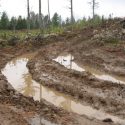Team tracks the uncertain climate footprint of wetlands
Ankur Desai, professor of atmospheric and oceanic sciences at UW–Madison, photographed near Minocqua, Wisconsin, in 2011.
When is a wetland a sink and when is a wetland a source?
That is the question an international team of researchers set out to answer in a new study published online March 23 in the Proceedings of the National Academy of Sciences. Ankur Desai, professor of atmospheric and oceanic sciences at the University of Wisconsin–Madison, is one of just a few American scientists involved.
Wetlands both absorb carbon dioxide and emit methane, and scientists have long sought how to balance the two in the global greenhouse gas budget — particularly as humans change these natural ecosystems. The study presents real-world data useful to land managers, policymakers, climate scientists and others interested in the potential for wetlands to increase the effects of climate change or as part of the toolkit to combat it.
For starters, the study found that converting wetlands into cropland makes them a source of greenhouse gas and, while restoring wetlands can ultimately help absorb more carbon dioxide, young wetlands emit more methane than the carbon they store.
“There is a lot of interest in wetland restoration as a mitigation tool for climate change,” says Desai, also a scientist at the UW–Madison Nelson Institute for Environmental Studies Center for Climatic Research. “We need to make sure we’re right on top of how we’re accounting for that mitigation value.”
The study presents real-world data useful to land managers, policymakers, climate scientists and others interested in the potential for wetlands to increase the effects of climate change or as part of the toolkit to combat it.
The study, he says, is the first to achieve that with a large number of data points, having assessed the climate footprint of nearly 30 wetlands across the Northern Hemisphere, from Zackenberg, Greenland, to Sherman Island, California. With that data, the researchers created models to better understand the environmental and man-made conditions that alter the wetland greenhouse gas budget and show how land management can influence their behavior over time.
They wanted to know: “What is the long-term effect of methane emission and carbon dioxide uptake, and if we were to perturb this wetland — convert it to cropland or forest, which is the significant conversion going on globally — does this actually lead to a more positive radiative forcing or a more negative radiative forcing?” Desai says.
Radiative forcing is a measure of how much solar energy gets trapped on Earth. Greenhouse gases capture this solar radiation, heating the lower atmosphere and driving global weather and climate. Positive forcing indicates more energy is being trapped near the Earth’s surface, leading to warming.
Overall, the research team found there is no one-size-fits-all way to categorize the greenhouse gas budget of any individual wetland, and that their sink or source potential varies over space and time, in how they are managed, and whether they are converted to other land types, such as forestry lands or cropland.
The study models show that converting wetlands to agricultural land leads to warming, especially at arctic and boreal sites, while conversion for biofuel crops or into forestry land leads to negative radiative forcing. But this depends on how the land is managed.
“There is a lot of interest in wetland restoration as a mitigation tool for climate change. We need to make sure we’re right on top of how we’re accounting for that mitigation value.”
Ankur Desai
For the study, Desai ran continuous meteorological and greenhouse gas measurements at a wetland site in Park Falls, Wisconsin, and contributed to statistical analysis and preparation of the published paper. He is part of a large network of scientists around the world, called FLUXNET, leading energy and greenhouse gas research sites and sharing the data they collect.
The Park Falls site is a 1,300-foot (400-meter) instrumented tower, surrounded by natural and agricultural areas, that also serves as a state-owned public television tower for PBS station WLEF-TV. The site, which Desai and others (including colleagues at UW–Madison, the National Oceanic and Atmospheric Administration (NOAA), Penn State, and other universities) have long run, can measure directly the exchange of heat, water, momentum, carbon dioxide and methane between the Earth’s surface and atmosphere.
At each site in the study, which ranged from arctic and boreal locales to more temperate areas, like Park Falls, scientists measured the concentrations and dynamics of carbon and methane near both natural and managed (or created) wetlands, whenever possible. Wetlands cover somewhere between 3 and 10 percent of the globe, though an element of uncertainty in the study is the lack of a solid definition for what constitutes a wetland.
“If you ask a person on the street to define what is a wetland … it’s a political definition, officially,” says Desai, “because it’s related to restoration, protection of the landscape. It may be different from what matters to a natural ecosystem from the perspective of carbon and methane budgets, so that’s a challenge for sure.”
In general, wetlands serve as carbon dioxide sponges because the gas gets trapped in their cool, oxygen-poor, waterlogged soils. At the same time, microbes break down the rich organic matter wetlands contain and release their metabolic byproducts, including methane. Wetlands account for 30 percent of the global methane budget.
Unlike carbon dioxide, methane is relatively short-lived once released into the atmosphere, sticking around only a decade. However, because of its chemistry, methane ultimately converts to carbon dioxide in the atmosphere and, over a 100-year period, is 25 times more potent.
“There is more warming for a molecule of methane than for a molecule of carbon dioxide added to the atmosphere,” says Desai.
Even small changes to a wetland can alter the balance of greenhouse gas stored versus greenhouse gas emitted and it’s important to assess these contributions over time, Desai says — particularly as countries consider wetland restoration as a strategy to offset carbon dioxide emissions, as an alternative to reducing fossil fuels.
“We have to think carefully about what the actual contributions are because wetlands have been storing carbon for thousands of years,” says Desai. “Early restoration sites have enhanced methane emissions relative to carbon sink potential but what happens initially can be different from what happens 20 years out, from what happens 100 years out.”
The corresponding author of the study, which will be available in print this month, is Alessandro Cescatti with the European Commission-DG Joint Research Centre’s Institute for Environment and Sustainability Climate Risk Management Unit, but many researchers contributed and numerous grants supported the work, including the National Science Foundation.
Tags: climate change, environment



